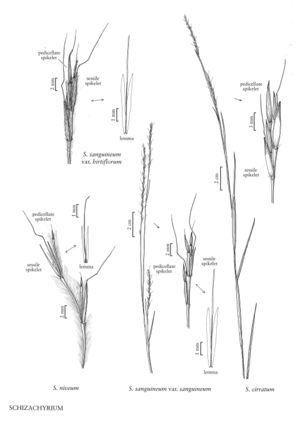Difference between revisions of "Schizachyrium sanguineum var. hirtiflorum"
Common names: Hairy crimson bluestem
Synonyms: Schizachyrium sanguineum var. brevipedicellatum Andropogon hirtiflorus var. feensis
Treatment appears in FNA Volume 25. Treatment on page 674.
imported>Volume Importer |
imported>Volume Importer |
||
| Line 47: | Line 47: | ||
|publication year= | |publication year= | ||
|special status= | |special status= | ||
| − | |source xml=https:// | + | |source xml=https://bitbucket.org/aafc-mbb/fna-data-curation/src/2e0870ddd59836b60bcf96646a41e87ea5a5943a/coarse_grained_fna_xml/V25/V25_1621.xml |
|subfamily=Poaceae subfam. Panicoideae | |subfamily=Poaceae subfam. Panicoideae | ||
|tribe=Poaceae tribe Andropogoneae | |tribe=Poaceae tribe Andropogoneae | ||
Revision as of 21:03, 5 November 2020
Culms 40-120 cm, branching at the upper nodes, glau-cous. Ligules 1-2 mm; blades 10-20 cm long, 1.5-5 mm wide. Rames 4-10(12) cm; internodes scabrous, glabrous or hirsute. Sessile spikelets 5-9 mm; lower glumes sparsely to densely hirsute on the back; awns 15-25 mm. Pedicels arcuate at maturity, ciliate on both edges distally. Pedicellate spikelets 3-5 mm, staminate or sterile, awns 0.3-5 mm. 2n = 40, 60, 70, 100.
Distribution
Puerto Rico, N.Mex., Tex., Ala., Ga., Ariz., Fla.
Discussion
In the Flora region, Schizachyrium sanguineum var. hirtiflorum grows on rocky slopes and well-drained soils from Arizona to southwestern Texas and Florida, and is considered a good forage species. Its range extends through Central America to Chile, Paraguay, and Uruguay.
Selected References
None.
Lower Taxa
None.
